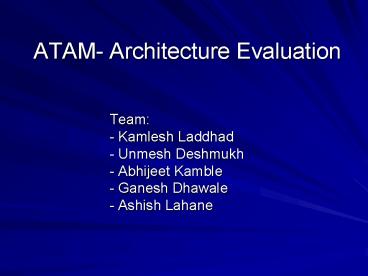ATAM- Architecture Evaluation PowerPoint PPT Presentation
1 / 17
Title: ATAM- Architecture Evaluation
1
ATAM- Architecture Evaluation
- Team
- - Kamlesh Laddhad
- - Unmesh Deshmukh
- - Abhijeet Kamble
- - Ganesh Dhawale
- - Ashish Lahane
2
Whats ATAM
- To evaluate the architecture, SEI has developed
the Architecture Tradeoff Analysis Method (ATAM). - Purpose To assess the consequences of
architectural decisions in light of quality
attribute requirements. - Primarily a risk identification mechanism
- Not a predictor of quality achievement
3
ATAM - Vocabulary
- Scenario A scenario is a short statement
describing an interaction of one of the
stakeholders with the system - Stakeholder An individual, team, or
organization (or classes thereof) with interests
in, or concerns relative to, a system - Architectural view A representation of a whole
system from the perspective of a related set of
concerns - Utility - An expression of the overall goodness
of the system.
4
System Quality Attribute
- Time To Market
- Cost and Benefits
- Projected life time
- Targeted Market
- Integration with Legacy System
- Roll back Schedule
- Performance
- Availability
- Usability
- Security
Business Community view
End Users view
- Maintainability
- Portability
- Reusability
- Testability
Developers view
5
ATAM Steps
- Evaluators and decision makers
- Present
- ATAM
- Business drivers
- Architecture
- Identify architectural approaches
- Generate quality attribute utility tree
- Analyze architectural approaches
- Evaluators, decision makers along with
stakeholders - Brainstorm and prioritize scenarios
- Present results
6
Present ATAM
- Evaluation Team presents an overview of the ATAM
- ATAM steps in brief
- Techniques
- - utility tree generation
- - scenario brainstorming/mapping
- Outputs
- - utility tree
- - scenarios
- - risks and non-risks
- - sensitivity points and tradeoffs
7
Present Business Drivers
- ATAM customer representative describes the
systems business drivers including - Business context for the system
- High-level functional requirements
- High-level quality attribute requirements
- Architectural drivers quality attributes that
shape the architecture - Critical requirements quality attributes most
central to the systems success
8
Present the Architecture
- Architect presents an overview of the
architecture including (for example) - Technical constraints such as an OS, hardware,
or middle-ware prescribed for use - Other systems with which the system must interact
- Architectural approaches/styles used to address
quality attribute requirements
9
Identify Architectural Approaches
- Start to identify places in the architecture that
are key for realizing quality attribute goals. - Identify any predominant architectural approaches
for example - client-server
- 3-tier
- proxy
- publish-subscribe
- redundant hardware
10
Generate Utility Tree
- Identify, prioritize, and refine the most
important quality attribute goals by building a
utility tree. - A utility tree is a top-down vehicle for
characterizing the driving attribute-specific
requirements - Select the most important quality goals to be the
high-level nodes (typically performance,
modifiability, security, and availability) - Scenarios are the leaves of the utility tree
- Output a characterization and a prioritization
of specific quality attribute requirements. - Scenarios are used to
- Represent stakeholders interests
- Understand quality attribute requirements
- A good scenario makes clear what the stimulus is
that causes it and what responses are of
interest.
11
Typical Utility Tree
12
Scenario Examples
- Use case scenario
- Remote user requests a database report via the
Web during peak period and receives it within 5
seconds. - Growth scenario
- Add a new data server to reduce latency in
scenario 1 to 2.5 seconds within 1 person-week. - Exploratory scenario
- Half of the servers go down during normal
operation without affecting overall system
availability. - Scenarios should be as specific as possible.
13
Sensitivity Tradeoffs
- Stakeholders will join form this step.
- Sensitivity
- A property of a component that is critical to
success of system. - The number of simultaneous database clients will
affect the number of transaction a database can
process per second. This assignment is a
sensitivity point for the performance - Keeping a backup database affects reliability.
- Power of encryption (Security) sensitive to
number of bits of the key - Tradeoff point
- A property that affects more than one attribute
or sensitivity point. - In order to achieve the required level of
performance in the discrete event generation
component, assembly language had to be used
thereby reducing the portability of this
component. - Keeping the backup database affects performance
also so its a trade-off between reliability and
performance.
14
Risks Non-Risks
- Risk
- The decision to keep backup is a risk if the
performance cost is excessive - Rules for writing business logic modules in the
second tier of your 3-tier style are not clearly
articulated. This could result in replication of
functionality thereby compromising modifiability
of the third tier. - Non Risk
- The decision to keep backup is a non-risk if the
performance cost is not excessive - Assuming message arrival rates of once per
second, a processing time of less than 30 ms, and
the existence of one higher priority process, a 1
second soft deadline seems reasonable
Performance.
15
Brainstorm Prioritize Scenarios
- Stakeholders generate scenarios using a
facilitated brainstorming process. - Scenarios at the leaves of the utility tree serve
as examples to facilitate the step. - The new scenarios are added to the utility tree
16
Present ATAM results
- Utility tree.
- Set of Scenarios.
- Risks and non-risks
- Sensitivity points and tradeoffs.
17
DEMO

